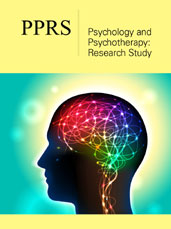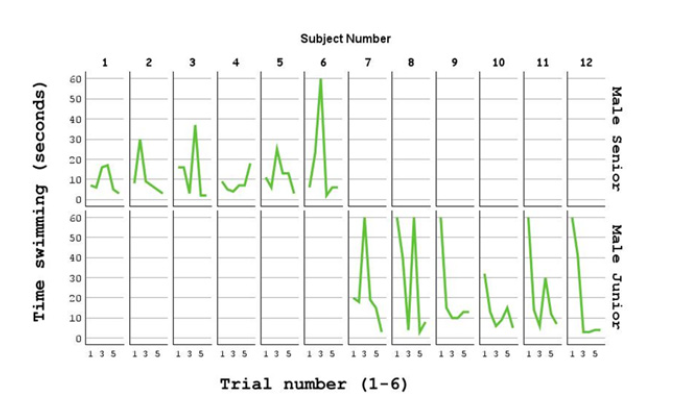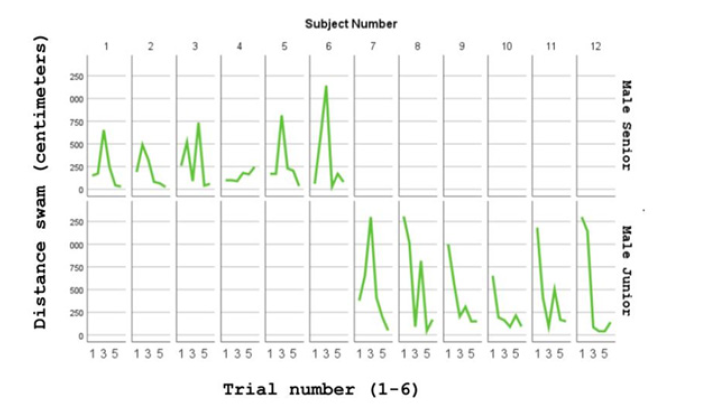- Submissions

Full Text
Psychology and Psychotherapy: Research Studys
Aging Might Increase Efficiency in Behavioral Performance for Risk Situations
Alicia Garcia-Falgueras*
Netherlands Institute for Neurosciences, Netherlands
*Corresponding author: Alicia Garcia- Falgueras, Netherlands Institute for Neurosciences, Netherlands
Submission: August 09, 2024;Published: September 27, 2024

ISSN 2639-0612Volume8 Issue3
Abstract
There are many examples in the Scientific literature about the changes and deterioration of memory through ages in humans. However, very little is written about the possible improvements of behavioural outputs with aging by better discerning use of alerting attentional resources. In this brief report we have shown in rodents how attentional skills and abilities to solve unknown and risky situations might be different between ages. Using domestic rodents and Morris maze tests, the performance of two age cohorts (4 months vs 1 months of age) were significantly different for the first trials in time swimming and swim length. Anxiety, rapidity of uncoordinated movements and thigmotaxis were predominant in the junior groups at the beginning, while the senior group presented also a nervous behaviour but more controlled. Although the younger group quickly learned how to escape and reach the adult level soon. Some research about human attentional skills and amygdala selection of external stimuli during lifespan are discussed.
Keywords:Morris maze; Memory; Stages; Cognitive mapping; Global positioning system; GPS; Arousal; Learning; Evocation; Hippocampus; Escape
Introduction
Efficiency is the extent to which time or effort is well used for the intended task or purpose. In network Sciences efficiency is a measure which indicates how efficiently a network exchanges information, but in Statistics, it also represents a measure of quality of an estimator, experiment or text. In terms of energy, efficiency is the ratio of power consumed to useful power output. Useful, good use of power, proper links, quality, etc. they all seem to be positive values for pursuit of efficiency.
There are many examples in the Scientific literature about the changes and deterioration of memory through ages in humans. However, very little is written about the possible improvements of behavioural outputs with aging by better discerning use of alerting attentional resources. For instance, it is well known that semantic memory and short-term memory are well preserved most of the adult lifespan, but some specific changes might happen very late in healthy life. On the contrary, autobiographical memory, emotional memory and implicit memory are certainly unaffected by normal aging [1-7]. Some authors have mentioned changes in specific but not general attention skills with aging. In this line, alertness and working memory abilities might improve and some research is defining how to work for preventing the specific decline [4]. The hippocampus in the brain but also the amygdala might be very relevant for this purpose, since hippocampus helps to storage memories and amygdala is constantly monitoring signals from the environment and regulating the stimuli as possible threats to the organism like the “brain´s lighthouse”.
The use we have given to our brains and those two areas together with the external stimulation we might have received in life seem to be relevant for our attentional skills. For instance, one study pointed out how bilingualism provided advantages in cognitive control abilities such as alerting: adult bilinguals showed an increase in neurofunctional activity in the frontal and parietal areas when compared to young bilinguals (French-English) that was translated into a more efficiency response [2]: for establishing the state of alertness of the incoming stimuli, the alerting ability was improved in those bilingual older people. Extra brain networks happening in bilingualism, such as a stronger functional connectivity between anterior to posterior brain areas and frontoparietal cortex, might improve this efficiency of the alertness criteria.
We have checked, with a Morris maze test and using domestic rodents, how the first reaction to an aversive stimulus such as water was completely different in two groups of ages. Comparing junior and senior animals (few “human months’ ‘ of differences) the junior group were more anxious, visible with the naked eye, more scared and unable to control the situation during the first trials. After few trainings, they learned as the senior group, different procedures of approaching the platform in the Morris Maze, according to their search swimming strategies, from less to more focus on the goal of the platform. Through training, they went from thigmotaxis to direct approach, following the progressive actions, random, scanning, chaining, focal and directed (Rai et al., 2020). Thigmotaxis defines the behaviour of the animal which swims in reaction to the feelings of the water but with not a clear goal. Random defines the haphazard movements of the animal in the water without conscious choice. Scanning refers to the recursive and repetitive circles that an animal does in the same area and chaining is scanning which happens in several different areas. Focal swimming happens when the animal’s behaviour is clearly aimed to escape from there, but with no clear direction. However, in directed and direct behaviour, the platform is the goal where the animal straights all the movements toward. That means, the attention of the animal flows from the direct physical sensations (water, unstable and uninhabitable medium) to finding an exit, (the platform). And the faster the animals focus on and find the way out from that risky situation, the more efficient his behaviour results.
Method
A total of 12 domestic Mus Musculus, an adult group (N=6) of 4 months old (born 16th March) and a younger group (N=6) of 1 month old (born 9th and 12th June) were tested with a Morris Maze test. All experiments were approved by local authorities and were in accordance with the guidelines for animal experiments of the EU (Directive 2010/63/EU). All mice were group housed per ages and sexes at 25 °C, under 12h day/night cycle in comfortable beds of finely ground Spanish pine sawdust, hay, straw and rodent litter changed at least once every week. For proper cognitive and motor stimulation they were housed with rotating wheels (vertical and diagonal), colourful pipe tubes, outside and inside spacious nests and several height levels to roam around in each cage. The food provided was carefully chosen in a healthy variety following veterinary instructions for little rodent necessities: natural seeds without additives, nuts (pumpkin seeds, black sunflower seeds, walnuts, etc), pasta (raw macaroni), toasted bread crumbs, fresh and dry proteins (healthy live tenebrio molitor coleoptera, boiled eggs and dry cat food), mineral stone for rodents and clean fresh water ad libitum.
Experimental design: Morris water maze task in brief, a circular water tank (color: black, height: 31cm, diameter: 53cm, and 167cm of perimeter) was located 35cm away from the floor. The color of the water tank was transparent and the color of the plexiglassplatform was black as well, no additional color was added into the water. This circular platform (height: 11.5cm, and diameter: 8.5cm) was fixed at a particular location during each trial and it changed every time. Additionally, the platform was submerged to a depth of 0.5-1cm above the water surface, but always depending on the size of the animal´s paws (water above the platform has to be the same to half the length of the rodent lower extremities). The recorder was done from a fixed place, located in the distance, providing a good view of the animal behavior, but with one blind spot, that was a traffic area. The recorder was stopped as soon as a mouse sat on a hidden platform or if the mouse swam for a maximum of 60s per trial without finding the platform. Mice had to learn to find a hidden platform using distal spatial cues because it was assumed they were able to distinguish the clues in the surrounding environment by seeing and all of them were able to swim acceptably [7].
Two groups of male mice of different ages (N=12) were compared. Two dependent variables were registered: 1) latency in water till finding the platform (seconds) and 2) track length of the swimming (centimeters). Both groups of ages were, previously to the water test, highly externally stimulated (see material and methods) but during different periods of time according to their ages. They swam in a session of 6 trials, in consecutive days, at the same time (around 7pm, when sunsets and their biorhythms start to be more active). This testing environment of water reduces odor trial interferences [1]. Clean water was changed every two trials. Statistical analysis, graphs, tables and figures were made with IBM SPSS Statistic version 29.0.2.0 and PowerPoint for Windows. For inter-group comparisons the unilateral analysis of variance, with non-parametric Kruskal-Wallis and U-Mann Whitney were performed.
Results
Comparing senior vs junior performances, we found clear statistical group differences for the first trial time [F (1,13) =8.609, p=0.003], first trial distance [F (1,13) =8.308, p=0.004]) and the second trial (distance [F (1,13) =3.692, p=0.05]), having the junior group the longer marks (Figure 1 & Figure 2).
Figure 1:The graph is showing the individual performance in time (seconds) of each animal of both groups during swimming tests. It is noticeable how the younger subjects of the junior group (down line from 7 to 12 subjects) spent longer times in the swimming pool before finding the escape (platform). There was statistical group significance for the first trial, being the senior group faster and more efficient. (* p < 0.003 in trial 1).

Figure 2:The graph is showing the individual performance in distance (centimeters) of each animal of both groups during swimming tests. Again, it is visible how the younger subjects (down line from 7 to 12 subjects) travelled longer distances before finding the platform. There was statistical group significance for the first and second trials, being the senior group faster and more efficient (p < 0.004 in trial 1 and p < 0.05 in trial 2).

Discussion
In this paper we have shown how different aged cohorted mice react statistically differently to the same stimuli (Water Maze) during the first trials, proving their attentional skills and abilities to solve unknown situations might be different throughout lifetime. The senior group was able to improve efficiency by reducing costs of individual energy and maximizing benefits earlier than the junior group, which reacted at the beginning following closer signals of risks and danger of the water (thigmotaxis) instead of searching for an escape. In humans we have seen this age difference does appear in bilingual persons [2]: stronger brain networks because of bilingualism might cause a difference for establishing the state of alertness of the incoming stimuli. But in non-bilinguals there is also an age difference in human alerting that might be depending on the presentation, duration or persistence of the warning cue [5].
The term naive means inexpert or immature. The response one has toward dangerous stimuli is clearly depending on the previous experience. That means the brains and most likely the amygdala network for the selective attention and reaction toward dangerous stimuli might change through life. Consequently, an “inexperienced amygdala” might be costing extra energy and thus, inefficiency happens in finding an escape quickly. In humans, the decreases in local efficiency during tasks were associated with better working memory performance in both age cohorts. In this experiment the older participants had an increase in global efficiency because of a slight decrease in predicted working memory performance [6]. Researching with domestic mice has some particularities. These animals, in genes, behavior, brain material, etc. are exactly the same as experimental animals in an animal house of a lab (Mus Musculus). However, they are allowed to have a different treatment, more affectionate, by the researcher or caregivers, because they are like pets. The age difference between groups was minimum (3 months). The junior group was just recently weaned (at 21 days) but definitely this swimming experience helped them, of all ages, to improve their abilities and possibly their brain connections, to cope with other feasibly risky situations.
Acknowledgement
We would like to thank Prof. Swaab at the Netherlands Institute for Neuroscience for his suggestions and inspirational ideas. We would like to thank the editor and reviewers for their improvements. Moreover, I would like to thank my three and a half cats, who started my worries about caring for rodents (injured).
References
- Bromley Brits K, Deng Y, Song W (2011) Morris water maze test for learning and memory deficits in Alzheimer's disease model mice. J Vis Exp 20(53): 2920.
- Dash T, Berroir P, Joanette Y, Ansaldo AI (2019) Alerting, orienting, and executive control: The effect of bilingualism and age on the subcomponents of attention. Front Neurol 10: 1122.
- Hedden T, Gabrieli JD (2004) Insights into the ageing mind: a view from cognitive neuroscience. Nat Rev Neurosci 5(2): 87-96.
- Hsieh S, Chen EH (2023) Specific but not general declines in attention and executive function with aging: Converging cross-sectional and longitudinal evidence across the adult lifespan. Front Psychol 14: 1108725.
- Jennings JM, Dagenbach D, Engle CM, Funke LJ (2007) Age-related changes and the attention network task: an examination of alerting, orienting, and executive function. Neuropsychol Dev Cogn B Aging Neuropsychol Cogn 14(4): 353-369.
- Stanley ML, Simpson SL, Dagenbach D, Lyday RG, Burdette JH, et al. (2015) Changes in brain network efficiency and working memory performance in aging. PLoS One 10(4): e0123950.
- Vorhees CV, Williams MT (2006) Morris water maze: procedures for assessing spatial and related forms of learning and memory. Nat Protoc 1(2): 848-858.
© 2024 Alicia Garcia-Falgueras, This is an open access article distributed under the terms of the Creative Commons Attribution License , which permits unrestricted use, distribution, and build upon your work non-commercially.
 a Creative Commons Attribution 4.0 International License. Based on a work at www.crimsonpublishers.com.
Best viewed in
a Creative Commons Attribution 4.0 International License. Based on a work at www.crimsonpublishers.com.
Best viewed in 







.jpg)






























 Editorial Board Registrations
Editorial Board Registrations Submit your Article
Submit your Article Refer a Friend
Refer a Friend Advertise With Us
Advertise With Us
.jpg)






.jpg)














.bmp)
.jpg)
.png)
.jpg)










.jpg)






.png)

.png)



.png)






